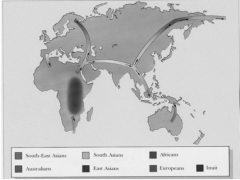![]()
![]()
![]()
Use LEFT and RIGHT arrow keys to navigate between flashcards;
Use UP and DOWN arrow keys to flip the card;
H to show hint;
A reads text to speech;
42 Cards in this Set
- Front
- Back
|
4 distinguishing features of Homo |
Large brain relative to body size tool making |
|
|
Homo habilis date |
2.4 MYA |
|
|
Who found Homo habilis? |
Leaky, Tobias and Napier |
|
|
Homo habilis location |
Kenya only found in Africa. |
|
|
Homo habilis brain size and nature |
550-700 cubic centimetres. advanced brain shape and volume. |
|
|
Homo habilis teeth nature |
narrow, sharp molars and premolars |
|
|
nature of Homo habilis face |
less prognathic |
|
|
nature of Homo habilis arms |
relatively long arms |
|
|
Define 'Habilis' |
Handy |
|
|
Homo erectus date |
1.8-1 MYA (oldest found at lake Turkana/Rudolf in Kenya) |
|
|
Homo erectus location |
Lake Turkana Kenya/ Asia and possibly Europe |
|
|
Who found Homo erectus |
White in 1994 in Ethiopia |
|
|
Homo erectus brain size |
Large: 850-1200 cubic centimetres |
|
|
Homo erectus teeth relative to H. habilis |
smaller teeth than H. habilis |
|
|
Define 'erectus' |
upright posture |
|
|
list an example of Homo erectus and give a reason. |
KNM-ER 1500 "Turkana boy" from Kenya as it is the most complete fossil hominid ever found. it is a boy aged<12 years |
|
|
what is the nature of Homo erectus reletive to Homo sapiens? |
Skull is similar size but more robust. similar height to modern H. sapiens. |
|
|
Did Homo erectus make tools? |
Yes |
|
|
What did KNM-ER 60000 (Homo rudolfensis) prove? |
KNM-ER 60000, dating 1.78- 1.95 MYA prove that there were at least two contemporary HOMO lineages during the pleistocene. |
|
|
What were the nature of KNM-ER 60000's remains? |
A jaw and face were found |
|
|
Which Homo. is known as 'the Hobbit' |
Homo floresiencis |
|
|
what are 5 characteristics of Homo floresiencis |
Bipedal long arms primative teeth small brain tool maker |
|
|
Homo floresiencis location |
the island of Flores, Indonesia |
|
|
Homo floresiencis date and why is this significant |
95 000-13 000 years ago. Significant as this overlaps with H. sapiens who have lived here for 100 000 years |
|
|
How large is Homo floresiencis' brain relative to H. erectus and Australopithicenes? |
smaller than H. erectus and on the lower end of Australopithicenes |
|
|
What are the three hypotheses for Homo floresiencis' size? |
-Dwafed human (excavators) -Microcephalic human (tiny brain, normal face, small stature) -cretinism (hypothyroidism)-lack of idine. (Peter Obendorf and Charls Oxnard) |
|
|
Homo Neanderthalensis location |
-Neader Valley Germany -La Chapelle France -Shanidar Iraq |
|
|
Homo Neanderthalensis brain size and relation to that of modern humans |
1200-1900 cubic centimetres = of >modern humans |
|
|
nature of teeth in relation to humans |
smaller teeth than humans except incisors which are larger |
|
|
Facial characteristics |
very large nose mid-face projection slightly larger brow ridges than h. sapiens |
|
|
is Homo Neanderthalensis gracile or robust? |
Homo Neanderthalensis is more robust than H. sapiens= built for cold climates |
|
|
Mental characteristics |
tool making may have had language |
|
|
Homo sapiens date |
130 000-present |
|
|
Homo sapiens location |
Everywhere |
|
|
Early examples of Homo sapiens |
Border cave, South Africa Cro-Magnon, Europe Skuhl, Palestine |
|
|
Homo sapiens brain size |
1100-1800 cubic centimetres |
|
|
4 facial characteristics of Homo sapiens |
small to moderate brow ridges less prognathic face presence of a chin smaller teeth |
|
|
Homo sapiens climate |
originally warm |
|
|
mental characteristics |
tool making art language |
|
|
give an example of early human art |
Lascaux caves, France |
|

What did the pictured theory say about H. sapiens origin? |
'Out of Africa' Theory: humans evolved in Africa and then migrated all over the world. DNA evidence supports this theory. |
|

What did the pictured theory say about H. sapiens origin? |
Multi-regional theory: humans evolved in many different locations. |

